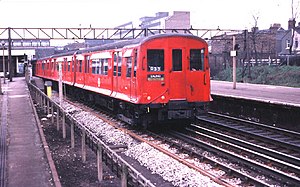Our website is made possible by displaying online advertisements to our visitors.
Please consider supporting us by disabling your ad blocker.
London Underground O and P Stock
| O Stock, P Stock, CO/CP Stock | |
|---|---|
 A CO stock train on the District line leaving Barking in 1980 | |
| Stock type | Subsurface |
| In service | 1937–1981 |
| Manufacturer | GRC&W BRC&W |
| Successor | |
| Specifications | |
| Car length | 51 ft (15.54 m) |
| Width | 9 ft 8+3⁄8 in (2.956 m) |
| Height | 11 ft 9+1⁄2 in (3.594 m) |
| Weight | 35.75 long tons (36.32 t; 40.04 short tons) |
| Seating | 42 |
| Notes/references | |
The London Underground O and P Stock electric multiple units were used on the London Underground from 1937 to 1981. O Stock trains were built for the Hammersmith & City line, using metadyne control equipment with regenerative braking, but the trains were made up entirely of motor cars and this caused technical problems with the traction supply so trailer cars were added. P Stock cars were built to run together with the O Stock cars now surplus on Metropolitan line Uxbridge services. The trains had air-operated sliding doors under control of the guard; the O Stock with controls in the cab whereas the P Stock controls in the trailing end of the motor cars. The P Stock was introduced with first class accommodation, but this was withdrawn in 1940.
In the early 1950s, some Uxbridge O and P Stock trains were transferred to the Circle line. The increasingly unreliable metadynes were replaced and the converted trains became known as CO/CP stock. In the early 1960s, the remaining Uxbridge CO/CP Stock trains were transferred to the District line, so that during the 1960s generally Hammersmith & City and Circle line services were operated by CO stock and CP stock was used on the District line. Following the introduction of C69 Stock in the early 1970s, all CO and CP Stock trains were used on the District line until they were replaced by the C Stock and D Stock trains, with the last train running in service in 1981.
Previous Page Next Page


